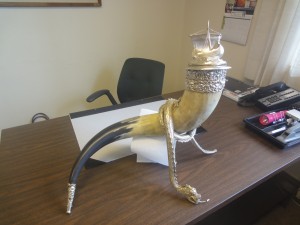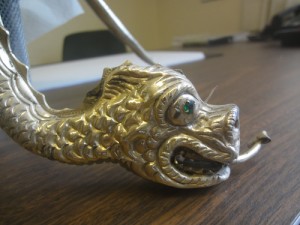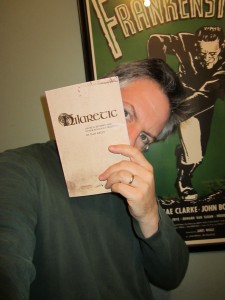I’m omitting the last names of several of this entry’s dramatis personae because the subject matter is rather sensitive. The Steppes of Chicago blog has been a great success in that we’ve received many interesting comments from folks who either live or lived in the neighborhoods we cover. Long-time Chicagoans tend to be entrenched (my own family’s lived in the region for over a century), and it’s likely the boy mentioned in this piece still has relatives in the area. Nothing can really be gained by putting his family name back in the public eye after 66 years, I think. At least in this instance. Agree? Disagree? Comment away!
If Frank T_________, age 13, was looking for a little attention, 1946 gave him more than he expected. Living with his mom and three younger sisters at 3838 Grand Ave. (still standing, though the former ground-floor tavern is now a Vienna Beef hot dog joint), Frank knew tragedy early on. The previous year his father Anthony was killed at 4207 North Ave. Mistaking the apartment for his sister-in-law’s place, Anthony was shotgunned by Mr. Edgar B_____ and died the exceedingly young age of 34. Left to raise four kids, Lillian T________, 33, presumably did the best she could. However, a subsequent series of Tribune articles from that year reveal that young Frank wasn’t always operating under adult supervision.
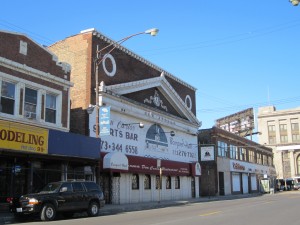
His first appearance is a lark, or at least a schoolboy prank (interestingly, he was a schoolboy at Our Lady of the Angels School, though many years before the fire). On March 15, 1946, Frank and his buddies decided to break in and skulk around the abandoned New Apollo Theater at 1536 N. Pulaski. One can completely understand why the place would be irresistible to adventurously stupid young boys. Built in 1913, it closed after 20 years and was left to rot. One reporter’s account describes a cavernous, ramshackle deathtrap, complete with collapsing walls, drooping floors, trapdoors, and copious cobwebs straight out of a Universal monster flick. What preteen lad with more curiosity than brains wouldn’t want to explore it?

"Hey, Dewey! Do you think we'll find pirate treasure down ther...AGGGGGHHHHHHHHHH!"
Eight years before Frank and his friends showed up, Dewey B_______, 14—who lived next door—and Donald J______, also 14, tried to enter the place on August 17. Accessing the roof—perhaps from Dewey’s building—they chose a ventilator shaft as their point of entry. Undoubtedly surprised when the shaft door beneath them collapsed, they soared straight down. God loved fools and children even then, because Dewey and Donald (Huey and Louie were likely elsewhere) fell only 15 to 20 feet to the rafters, rather than farther down to the theater floor. Donald broke a leg, while Dewey broke his right arm, making him the obvious choice to crawl out and seek assistance. Finding his way out, he called for help, and firemen arrived to rescue the two early urban explorers from the theater and themselves.
That the theater remained standing until Frank’s prepubescence is remarkable. At a guess, the place acquired a taboo cachet ever since Dewey and Donald’s misadventure. Likely, many others entered the place before and after, but Frank’s is the only trip (besides the other boys’) that’s on the record.
As Frank and his buddies walked the aisles, a local flatfoot grew wise, entered, and ordered them out. His friends scattered, and our young hero ducked under a stage trapdoor, closed it, and discovered a tunnel about 3 1/2 by 3 1/2 foot high. As with many a boy before him, “tunnel” equaled “adventure,” and Frank crawled on, apparently not bothered by the ickiness and vermin one would expect in the innermost recesses of an abandoned movie house. Apropos to the occasion, the tunnel, Frank reported, ended in a four foot by four foot room littered with business cards, crumpled rags, a derby with a hole through it, and your standard human skeleton.
With only two short articles covering the story, the sequence of events grows murky, so bear with me.
When he saw the bones, Frank claimed he yelled in terror and crawled back out. I picture him yammering like Lou Costello about the sk-sk-sk-skeleton down there to the cop who told him to scram.
Later on, he gathered his courage in the presence of the cops and reporters and went back into the tunnel, emerging with the battered hat and stack of cards. A photograph accompanying the Trib story shows him holding A hat, sticking his index finger through A hole, but you have to wonder why the cops were letting him handle potential evidence. Perhaps a photographer or reporter found an old chapeau and said, “Hey, kid. Hold this for minute, willya?” Certainly not.
The stack of cards was interesting. It contained two fraternal order membership cards (which organization wasn’t specified) for Messrs. Karl H. Weis and H. Austenmueller, and numerous “theater cards”—presumably advertisements for various shows. The cards came from the days that were considered the “good old days” even in 1946. The cops traced them to Mr. Weis, who ran a bakery at 1744 W. 35th St. Weis remembered having the cards, said he had Mr. Austenmueller’s card after paying his membership fee, and further stated he’d lost the cards while changing a tire on Elston Avenue back in 1919. As to how they ended up under the New Apollo Theater, he had no idea. A likely story.

This is a 1902 photo from the Oriental Institute at U of C. But you get the idea.Cite as: DN-0000217, Chicago Daily News negatives collection, Chicago History Museum.
Actually, it was an irrelevant story. There was still the little matter of retrieving the skeleton. When the cops went to recover it, they found two feet of water in the tunnel Frank failed to mention. The fire department planned to pump it out, but now Frank claimed that when he went back in, he found a note stating: “You will not find the cave or the body. I toke (sic) it with me.”
Without perusing the entire March 15, 1946 Tribune, the evidence suggests it was either a slow news day, or Col. McCormick didn’t have competent fact-checkers on the payroll. The next day the entire affair was revealed to be a hoax. Austin Police Captain Thomas Duffy took Frank aside and suggested he ‘fess up. The kid crumbled and said “I was only fooling, captain.”, and claimed he got the idea for the prank after seeing skeletons on display at the [Field] Natural History Museum the week before. The ventilated hat came to him after seeing “a moving picture murder mystery,” which just goes to show that movies and museums promote juvenile delinquency. Rather than booking him, the cops took Frank home. No foul play, no harm.
Frank’s next bout with fame wasn’t so amusing. On June 27, he was lighting fire crackers in a lot beside his house while his little sister Delores, 12, stood back and watched. Fireworks have long been illegal in Illinois—the first of many laws passed in 1941—prompting our more law-aborting citizens to drive to Indiana, Michigan, Wisconsin, Kentucky, and Missouri for their Fourth of July an New Year’s fix. Frank shopped locally, purchasing his firecrackers from an “big boy” up north in a Niles forest preserve. Unwisely setting them off in a metal Christmas tree stand, the pyrotechnics went without incident until Frank reached the grand finale. The final firecracker must have been huge, chock full of black powder, because the resulting blast cracked windows in three nearby buildings. The tree stand blew all to hell, flinging a chunk of steel 100 feet toward Delores, gouging her left side. She was taken to now-closed Walther Memorial Hospital and stitched up. While the Trib took the opportunity to address the issue of firework safety and legislation, nothing more was said about what happened to Frank and Delores. Yet another photo of Frank accompanies the article, the handsome lad holding shards of the shattered tree stand, looking a bit dazed.
In a turn, Frank’s last appearance in the paper was heroic, but tragic. On the evening of October 6—two days before the 75th anniversary of the Great Chicago Fire—flames broke out in his younger sisters’ room. Waking up to billows of smoke, little Rose, 6, and Shirley, 7, crawled out of their room and hid in another (one news source says the bathroom, another says it was the bedroom next door). Smoke continued to fill the building as Frank ran through the place, frantically searching for his sisters. He was soon joined by Chicago Fire Captain Frank J. Kubek, who saw the smoke pouring out on his way to work. The two Franks met and searched for the girls, but became separated. Kubek found his way out again and attempted re-entry from the rear door, but as he passed the side of the house he looked up to see the boy dangling from a window ledge, forced out by the flames. Telling Frank to let go, the captain caught him, severely injuring his back in the process.
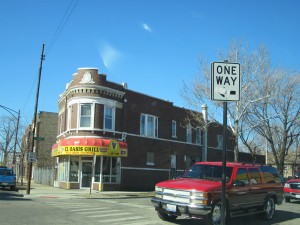
3838 Grand Ave.
During this time a neighbor, Henry Sandel (perhaps Sandei—the grittiness of the microfilm scan makes it difficult to determine), set off the fire alarm before heading into the flames to help. He was able to rescue mother Lillian and daughter Delores, guiding them out before rushing back in to help Kubek.
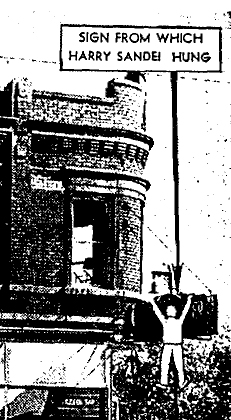

The two men thought they heard screams coming from the bathroom, and tried to kick in the door, but the fire forced them back, searing Sandel’s face, arms, and hands. Kubek found his way out, but Sandel had to exit a second-story window, smashing through the glass, grabbing hold of the tavern sign hanging outside, and dropping to the sidewalk without further damage. Horrifically, the sisters had suffocated by this point. Frank’s final Tribune photograph is a study in grief, he and his surviving sister Delores resting their heads against their mother’s sagging shoulders.
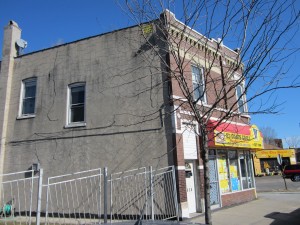
For us, perhaps charitably, that’s everything we know about young Frank T______, though there’s likely a family history somewhere that goes further. With hope he led a quieter life. A single family genealogy site reveals that he died in California in 1992. After a quick mental calculation, I realized that if he’d lived to the present day, Frank would be as old as my own father (living on the South Side the same time rank was living in Humboldt Park) today.
